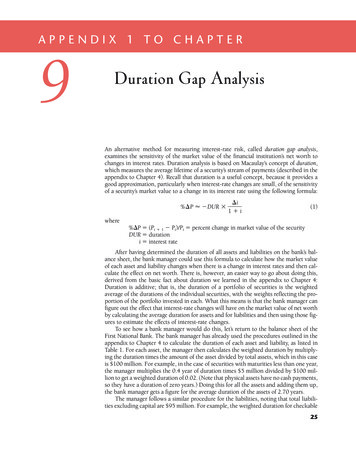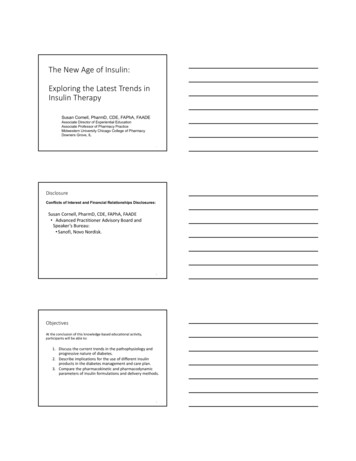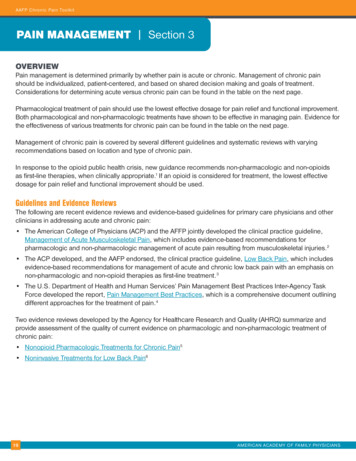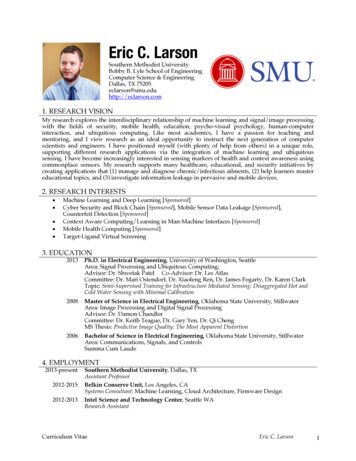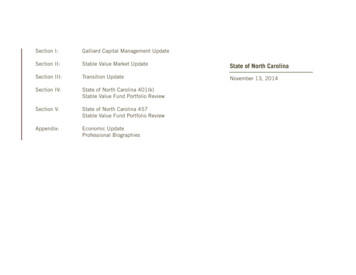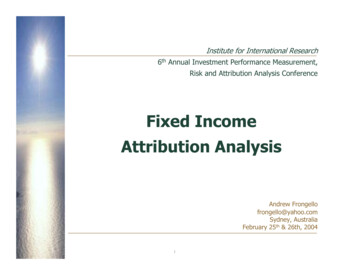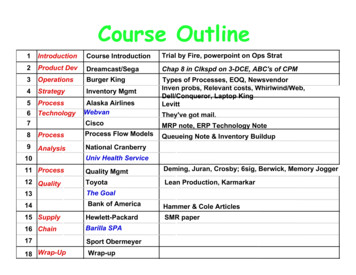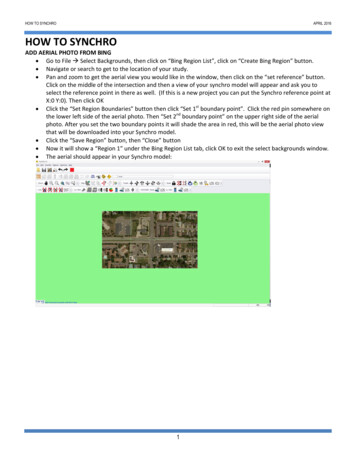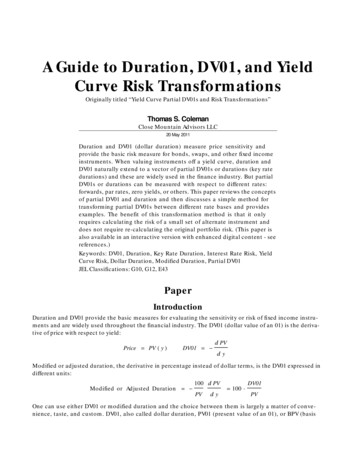
Transcription
A Guide to Duration, DV01, and YieldCurve Risk TransformationsOriginally titled “ Yield Curve Partial DV01s and Risk Transformations”Thomas S. ColemanClose Mountain Advisors LLC20 May 2011Duration and DV01 (dollar duration) measure price sensitivity andprovide the basic risk measure for bonds, swaps, and other fixed incomeinstruments. When valuing instruments off a yield curve, duration andDV01 naturally extend to a vector of partial DV01s or durations (key ratedurations) and these are widely used in the finance industry. But partialDV01s or durations can be measured with respect to different rates:forwards, par rates, zero yields, or others. This paper reviews the conceptsof partial DV01 and duration and then discusses a simple method fortransforming partial DV01s between different rate bases and providesexamples. The benefit of this transformation method is that it onlyrequires calculating the risk of a small set of alternate instrument anddoes not require re-calculating the original portfolio risk. (This paper isalso available in an interactive version with enhanced digital content - seereferences.)Keywords: DV01, Duration, Key Rate Duration, Interest Rate Risk, YieldCurve Risk, Dollar Duration, Modified Duration, Partial DV01JEL Classifications: G10, G12, E43PaperIntroductionDuration and DV01 provide the basic measures for evaluating the sensitivity or risk of fixed income instruments and are widely used throughout the financial industry. The DV01 (dollar value of an 01) is the derivative of price with respect to yield:Price PV H y LDV01 -â PVâyModified or adjusted duration, the derivative in percentage instead of dollar terms, is the DV01 expressed indifferent units:Modified or Adjusted Duration -100 â PVPVây 100 DV01PVOne can use either DV01 or modified duration and the choice between them is largely a matter of convenience, taste, and custom. DV01, also called dollar duration, PV01 (present value of an 01), or BPV (basispoint value), measures the derivative in price terms: the dollar price change per change in yield. Modifiedduration measures the derivative in percent terms as a semi-elasticity: the percent price change per changein yield. I will work mostly with DV01 throughout this paper but the ideas apply equally well to modifiedduration.
2temp.nbOne can use either DV01 or modified duration and the choice between them is largely a matter of convenience, taste, and custom. DV01, also called dollar duration, PV01 (present value of an 01), or BPV (basispoint value), measures the derivative in price terms: the dollar price change per change in yield. Modifiedduration measures the derivative in percent terms as a semi-elasticity: the percent price change per changein yield. I will work mostly with DV01 throughout this paper but the ideas apply equally well to modifiedduration.In practice a bond or other fixed-income security will often be valued off a yield curve, and we can extend theDV01 and duration to partial DV01s or key rate durations - the partial derivatives with respect to yields fordifferent parts of the curve:Partial DV01 s J¶ PV¶ y1º¶ PV¶ ykNCalculating and using partial DV01s based on a curve is a natural extension of the basic yield DV01, just aspartial derivatives are a natural extension of the univariate derivative. Partial DV01s of one form or anotherhave been used for years throughout the financial industry (see Ho 1992 and Reitano 1991 for early discussions). There is, however, one important difference. For the basic DV01 there is a single, effectively unique,yield for defining the derivative. Partial DV01s involve a full yield curve. Because the yield curve can beexpressed in terms of different yields and there is no one best set of yields, partial DV01s can be calculatedwith respect to a variety of possible yields. The values for the partial DV01s will depend on the set of ratesused, even though partial DV01s calculated using alternate yields all measure the same underlying risk. Usingdifferent sets of yields - sensitivity to parts of the curve - simply measures risk from different perspectives.Sometimes it is more convenient to express partial DV01s using one set of rates, sometimes another. Inpractice it is often necessary to translate or transform from one set of partial DV01s to another.An example will help clarify ideas. Say we have a 10 year zero bond. Say it is trading at 70.26 which is a3.561% semi-bond yield. The total DV01 will beDV01 sab -â PVâ y sab 6.904 100 bp .This is measured here as the price change for a 100 notional bond per 100bp or 1 percentage point change inyield. The modified duration for this bond will beModD 100 6.90470.26 9.83 % 100 bpThe modified duration is measured as the percent change in price per 1 percentage point change in yield.As pointed out above, there is a single yield-to-maturity for the bond and so little choice in defining the DV01or duration. When we turn to valuation using a curve, however, there are many choices for the yields used tocalculate the partial DV01s. The exact meaning of “ parts of the curve”is discussed more [below] [in thecompanion paper], but for now we restrict ourselves to a curve built with instruments with maturity 1, 2, 5,and 10 years. A natural choice, but by no means the only choice, would be to work with zero-coupon yields ofmaturity 1, 2, 5, and 10 years. Using such a curve and such rates for our 10 year zero the partial DV01s wouldbe:Table 1 - Partial DV01(w.r.t. zero yields) for 10 Year Zero Bond10-year Zero Bond Zero Yield Partial DV011yr Zero 2yr Zero 5yr Zero 10yr Zero Total0.0.0.6.9046.904The 10-year partial DV01 and the sum of the partial DV01s is the same as the original total DV01. This shouldnot be a surprise since both the partial DV01 and the original DV01 are calculated using zero yields.Zero yields are a convenient choice for this particular bond but are not the only choice. We could equallywell calculate the risk using yields on par swaps or bonds, shown in table 2.
temp.nb3Zero yields are a convenient choice for this particular bond but are not the only choice. We could equallywell calculate the risk using yields on par swaps or bonds, shown in table 2.Table 2 - Partial DV01(w.r.t. par yields) for 10 Year Zero Bond10-year Zero Bond Par Yield Partial DV011yr Swap 2yr Swap 5yr Swap 10yr Swap Total-0.026-0.105-0.547.5976.926It is important to note that in the two examples the exact numbers, both the distribution across the curveand the total (a “ parallel”shift of 100bp in all yields) are different. Nonetheless the risk is the same in both.The partial DV01s are simply expressed in different units or different co-ordinates - essentially transformedfrom one set of rates or instruments to another.Usually we start with risk in one representation or in one basis, often dependent on the particular risk systemwe are using, but then want to use the partial DV01s calculated from another set of yields. We might be giventhe zero-rate partials but wish to see the par-yield partial DV01s. We would need to transform from the zerobasis to the par basis.This paper describes a simple methodology for transforming between alternate sets of rates or instruments.The essence of the approach is:èStart with partial DV01s (for our security or portfolio) calculated in one representation, usually based onthe risk system used and the particular functional form used to build the curve.èPick a set of instruments that represent the alternate yields or rates desired for the partial DV01s. Forexample if we wish to transform to par bond yields, choose a set of par bonds.èPerform an auxiliary risk calculation for this set of alternate instruments to obtain partial derivatives,reported on the same basis as the original risk.èUse this matrix of partial derivatives to create a transformation matrix, and transform from the originalpartial DV01s to the new partial DV01s by a simple matrix multiplication.The matrix provides a quick, computationally efficient way to transform from the original DV01s to the newDV01s, essentially a basis or coordinate transformation. The benefit of this transformation approach is that itdoes not require us to re-calculate the sensitivities or DV01s for the original portfolio risk, a task that is oftendifficult and time-consuming. The auxiliary sensitivity calculations for the set of alternate instruments willgenerally be quick, involving valuation of a handful of plain-vanilla instruments.Review of DV01, Duration, Yield Curves, and Partial DV01Duration and DV01 are the foundation for virtually all fixed income risk analysis. For total duration or DV01(using the yield-to-maturity rather than a complete yield curve) the ideas are well-known. Nonetheless, itwill prove useful to review the basic concepts. Partial DV01s or key rate durations are used throughout thetrading community but are less well-known to the general reader. Partial DV01s become important when wevalue securities off a yield curve or forward curve. We will thus provide a brief review of forward curves, thenturn to the definition and caluclation of partial DV01s. Finally we will discuss some examples of using partialDV01s for hedging, to motivate why it is so often necessary to use partial DV01s calculated using differentrate bases and why transforming between partial DV01s is so important.Total DV01 and DurationThe duration we are concerned with is modified duration, the semi-elasticity, percentage price sensitivity orlogarithmic derivative of price with respect to yield:Modified or Adjusted Duration -1 âVVây -â ln Vây(1)The name duration originated with Frederick Macaulay (1938) and his definition of duration as the weightedaverage maturity of cash flows, using the present value of cash flows as weights:
4temp.nbThe name duration originated with Frederick Macaulay (1938) and his definition of duration as the weightedaverage maturity of cash flows, using the present value of cash flows as weights:Macaulay Duration â t inPV i(2)Vi 1Macaulay duration applies to instruments with fixed cash flows (t i is the maturity of cash flow i, PV i is thepresent value of cash flow i, and V is the sum of all PVs). Macaulay duration is a measure of time or maturity(hence the name “ duration”), and is measured in years. This is in contrast to modified duration, which is arate of change of price w.r.t. yield and is measured as percent per unit change in yield.The shared use of the term “ duration”for both a maturity measure and a price sensitivity measure causesendless confusion but is deeply embedded in the finance profession. The shared use of the term arisesbecause Macaulay duration and modified duration have the same numerical value when yield-to-maturity isexpressed continuously-compounded. For a flat yield-to-maturity and continuously-compounded rates thesum of present values is:V â PV i â CF i e -ti ynni 1i 1Taking the logarithmic derivative w.r.t. y gives:ModD CFi e - ti Vyis justPV iVnâyVBut note that the term â ti1 âVCF i e -ti yVi 1so that this is also the formula for Macaulay duration, and somodified duration and Macaulay duration have the same numerical value.In the more common situation where rates are quoted periodically-compounded, then the sum of presentvalues will be:V â PV i ânni 1i 1CF iI 1 y k M k tiwhere k is the compounding frequency (e.g. 1 for annual, 2 for semi-annual). Taking the logarithmic derivative in this case gives:1 âVModD -Vây â tini 11CF i1V I 1 y k M k ti I 1 y k MThis can be written asModD â t ini 1PV iV1I1 y k Mwhich gives the oft-quoted relation:ModD MacDI1 y k M(3)It is vitally important to remember, however, that this expresses a relationship between the values of modified and Macaulay duration (for fixed cash flow instruments such as bonds) but that the two measures areconceptually distinct in spite of sharing the name. Macaulay duration is a measure of time, denoted in years.Modified duration is a rate of change, percentage change in price per unit change in yield. Macaulay durationis limited in application to instruments with fixed cash flows (such as standard bonds) while modified duration can be applied to more general fixed-income instruments such as options.
It is vitally important to remember, however, that this expresses a relationship between the values of modified and Macaulay duration (for fixed cash flow instruments such as bonds) but that the two measures are5conceptually distinct in spite of sharing the name. Macaulay duration is a measure of time, denotedtemp.nbin years.Modified duration is a rate of change, percentage change in price per unit change in yield. Macaulay durationis limited in application to instruments with fixed cash flows (such as standard bonds) while modified duration can be applied to more general fixed-income instruments such as options.When we turn to DV01 we calculate the dollar (rather than percentage) change in price with respect to yield:DV01 -âV(4)âyDV01 is also called dollar duration, BPV (basis point value), Risk (on the Bloomberg system), or PV01(present value of an 01, although PV01 more accurately refers to the value of a one dollar or one basis pointannuity). The relation between DV01 and modified duration is:ModD 100 DV01DV01 VModD V(5)100The issue of units for measuring DV01 can be a little confusing. For notional bonds such as we are considering here, the DV01 is usually measured as dollars per 100bp change in yields (for 100 notional bond). Thisgives a value for DV01 of the same magnitude as the duration - on the order of 8 for a 10 year bond. This isconvenient for notional bonds, but for actual portfolios the DV01 is more often measured as dollars per 1bpchange in yields (thus the term dollar value of an 01 or 1bp). For 1mn notional of a 10 year bond this willgive a DV01 on the order of 800.The concepts of duration and DV01 become more concrete if we focus on specific examples. Consider a twoyear and a ten year bond, together with two and ten year annuities and zero bonds. Table 3 shows thesebonds, together with assumed prices and yields.Table 3 - DV01 and Durations For Selected Swaps, Annuities, and Zero-Coupon BondsInstrument Coupon H%L Price Yield H%L2yr Bond2.5100.2.55yr Bond3.100.3.10yr Bond3.5100.3.52yr Ann2.54.862.310yr Ann3.529.723.222yr Zero0.95.142.5110yr Zero0.70.283.56DV01 Mod Dur Mac 41.464.914.981.881.972.6.99.8210.DV01 is thedollarchangefor a 100 notional instrumentper100bp changein yield.Modifieddurationis thepercentchangeper100bpchange in yield.Macaulaydurationis theweightedaveragetime to maturity,in years.The DV01 is the change in price per change in yield. It can be calculated (to a good approximation) by bumping yield up and down and taking the difference; i.e. calculating a numerical derivative. For example the tenyear bond has a yield-to-maturity of 3.50% and is priced at 100. At 10bp higher and lower the yields are 3.6%and 3.4% and the prices are 99.1664 and 100.8417. The DV01 is approximately:DV0110yr bond 100.8417 - 99.16643.6 - 3.4 8.38The modified duration can be calculated from the DV01 using the relation in (5). The Macaulay duration canthen be calculated using the relation (3) or the original definition (2). For the table above, and in most practical applications, it proves easier to calculate a numerical derivative approximations to either DV01 or modified duration (1 or 4) and then use the relations (3) and (5) to derive the other measures.As pointed out, the DV01 measures sensitivity in dollar terms, the modified duration in percentage terms.Another way to think of the distinction is that DV01 measures the risk per unit notional while the durationmeasures risk per 100 invested. Comparing the 10 year bond and the 10 year annuity in table 3 help illustratethe distinction. The 10 year bond is 100 notional and also 100 present value ( 100 invested). The DV01 andthe modified duration are the same for both. The 10 year annuity is 100 notional but only 29.72 invested.The risk per unit notional (per 100 notional as displayed in table 3) is 1.46 for a 100bp change in yield. Therisk per 100 invested is 4.91, just the 1.46 “ grossed up”from 29.72 to 100.
As pointed out, the DV01 measures sensitivity in dollar terms, the modified duration in percentage terms.temp.nbAnotherway to think of the distinction is that DV01 measures the risk per unit notional while the durationmeasures risk per 100 invested. Comparing the 10 year bond and the 10 year annuity in table 3 help illustratethe distinction. The 10 year bond is 100 notional and also 100 present value ( 100 invested). The DV01 andthe modified duration are the same for both. The 10 year annuity is 100 notional but only 29.72 invested.The risk per unit notional (per 100 notional as displayed in table 3) is 1.46 for a 100bp change in yield. Therisk per 100 invested is 4.91, just the 1.46 “ grossed up”from 29.72 to 100.6Table 3 shows the Macaulay duration of the zero bonds are equal to maturity, as should be. The modifieddurations are slightly lower (dividing by one plus yield as per above), and the DV01s lower still (multiplyingby the zero prices, which are below 100). For the coupon bonds the Macaulay duration is less than maturity,reflecting the coupons that are paid prior to maturity.A good way to visualize the Macaulay duration is to imagine PVs of cash flows as weights placed on a balancebeam. Figure 1 shows the Macaulay duration for the two year annuity. The cash flows are 1.25 each halfyear, and the circles represent the PVs, which gradually decline further out. The fulcrum of the balance beamis just slightly less than the mid-point (1.24 years). If we drew the diagram for the two year bond there wouldbe a much large cash flow (the 100 principal) at year 2 and this is what pushes the Macaulay duration (thefulcrum on the balance beam) out to 1.96 years for the two year coupon bond.Figure 1 - Macaulay Duration for Two Year Annuitysecname2 yr AnnINTERACTIVE VERSION- select security 220.51.1.2091.1951.52.1.24Time0.51.This showstheMacaulaydurationas thefulcrumor balancepoint on a balancebeam,with weightsrepresentingthepresentvalueof cashflows. “ PV”is thepresentvalueof thecash flow.“ Time”is thematurityof thecash flow.The MacaulayDurationis shown at thefulcrum.Inthe .cdf/.nbpPlayerversionthetableis interactiveand thereadercan choosewhichsecurityis displayed.See referencesfor link tointeractiveversion.The equality (or near-equality) in the values of modified and Macaulay duration can be a valuable aid tointuition. Macaulay duration will always be less than the maximum maturity (equal only for a single cashflow, i.e. a zero-coupon bond, as seen in table 3 and the definition in equation 2). This means we can oftenmake a rough guess at the Macaulay duration and from that infer a rough value for the modified duration. Forexample a ten year bond will have Macaulay duration somewhat but not dramatically less than 10 years, andso the modified duration will be somewhat less than 10%. In table 1 we can see that the ten year bond has aMacaulay duration of 8.5 years and a modified duration of 8.4%.
The equality (or near-equality) in the values of modified and Macaulay duration can be a valuable aid totemp.nbintuition. Macaulay duration will always be less than the maximum maturity (equal only for a singlecash 7flow, i.e. a zero-coupon bond, as seen in table 3 and the definition in equation 2). This means we can oftenmake a rough guess at the Macaulay duration and from that infer a rough value for the modified duration. Forexample a ten year bond will have Macaulay duration somewhat but not dramatically less than 10 years, andso the modified duration will be somewhat less than 10%. In table 1 we can see that the ten year bond has aMacaulay duration of 8.5 years and a modified duration of 8.4%.Macaulay duration is useful as an aide for intuition but in measuring price sensitivity we must use eithermodified duration or DV01. In many cases one can use either, converting between them using equation (5)depending on the needs of the problem. Generally, managers of real-money long-only portfolios use modified duration while managers of trading and derivatives portfolios tend to use DV01. Modified duration iswell-suited for long-only portfolios, where risk and return can be measured as a percent of portfolio value,while DV01 is more suited to portfolios where the present value of the portfolio may be zero and measuringrisk in absolute or dollar terms is more convenient.In using duration we must be careful with a few points. First, we must keep straight the distinction betweenMacaulay duration (a measure of maturity) and modified duration (a measure of price sensitivity). Second,we must remember that (modified) duration tells us the price sensitivity to a change in rates, but does nottell us what rates we are sensitive to, in spite of the term “ duration”. Consider the ten year annuity, which hasa Macaulay and modified duration of roughly 5. The duration of 5 does not mean the annuity is sensitive tofive year rates or reacts in the same way as a five year bond. Think back to the fulcrum view from figure 1 - forthe annuity the fulcrum is in the middle and the cash flows at the far end depend on longer-dated rates. Forthe ten year annuity the fulcrum sits at roughly 5 years but there are cash flows extending out to ten years sothe ten year annuity will have sensitivity out to ten years.As a personal matter I usually use DV01 rather than duration. I prefer to sidestep the confusion between thedifferent meanings of the term “ duration”and find the concept of DV01 cleaner and simpler. Having statedmy preference, it is a personal preference and DV01 or modified duration can usually be used interchangeably. Throughout the rest of this paper, however, I will use DV01 rather than duration.Yield and ForwardCurvesPartial DV01s or key rate durations are a natural extension of the total DV01 or duration when we move topricing securities off a yield curve. To appreciate the how and why of partial DV01s we first need to brieflyreview yield or forward curves before turning to the definition of partial DV01s.The discussion above treated DV01 as a function of yield-to-maturity, essentially treating each bond orinstrument on its own, having its own yield. In many situations we will consider a set of bonds or instrumentstogether, all valued by discounting off a common market-based yield curve. Discounting cash flows off ayield curve or forward curve forms the foundation for all trading of fixed income instruments. An examplewould be a collection of swaps valued off a yield curve derived for a small set of on-the-run or active instruments (swaps, futures, libor deposits). The value of a swap will be the discounted value of future cash flows,discounting off the yield curve.Forward, Zero, and Discount CurvesThe most constructive way to think of a yield curve is as a function that provides the discount factor for anyday - for the zero bond discussed above we would want the discount factor 10 years in the future but for moregeneral instruments it might be any date from today out to 10 years in the future. It is particularly convenientto work with the forward curve f(t), where t is the maturity measured in years from today and f(.) is the instantaneous forward rate. Alternatively we could work with the zero-coupon yield curve z(t), or discount curved(t), but the three are related and so the choice becomes one of convenience. When we express rates continuously-compounded, the relations between the forward, zero, and discount curve are:zHtL Ù0 f HuL âutt
8temp.nbd H t L exp@ - z H t L t D expB - àtf HuL âuF .0In what follows I will often use the terms forward curve, yield curve, and zero curve interchangeably; since wecan always translate between the forward, zero, and discount functions this casual terminology should beacceptable. (Coleman 1998 discusses forward curves in more detail.)In general we want to be able to get the discount factor for any date; i.e. we want f(t) for any and all t. Marketdata (such as in table 4 below) never provide enough data to directly determine the discount factor for everyday. Instead we generally assume some parametric (but flexible) functional form for the forward curve,depending on parameters or variables H v1 º v k L . We then choose the parameters so that the curve pricesthe market data correctly. This means the forward / zero curve will be a function of the variablesH v1 º v k L .Example of Forward CurveAn example helps to explain and clarify how a yield curve is constructed and used. Say that the followingswaps are PV zero in the market, and we decide to use these as our market data:Table 4 - Hypothetical Market (Zero-PV) SwapsMaturity HyrsL Fixed Rate H%L1222.553103.5USD SwapsIn other words these are the current-market par swap rates. We can now build a forward or yield curve that isconsistent with these par swap rates, and which we can use to value these and other swaps.As an example of a functional form we can assume that instantaneous forward rates are constant betweeninstrument maturity points (break points or knot points) and that the forward rates jump at maturity points.In this case the variables H v1 º v k L are the forward rates between knot points. (This is, in fact, a practicaland useful forward curve often used by market practitioners, but it is only one among many.) Functionally,this is a piece-wise constant function:f1f2f3f400 t && t1 t && t2 t && t5 t && tTrue 1 2 5 10If we choose the forward rates to match the market data given in table 2, we get:0.01990.02990.03330.040600 t && t1 t && t2 t && t5 t && tTrue 1 2 5 10and graphically the forward function is a step function:Figure 2 - Piece-Wise Constant Forward Curve
turity H yrsLSolid are Zero Rates , Dashed are Forward RatesThese instantaneous forward rates are chosen so that the market instruments are priced correctly. We cannow use this forward curve to price arbitrary cash flows to obtain market-based prices of other instruments,prices that are consistent with the instruments shown in table 4.In practice swap curves are usually built with a variety of different instruments, including libor deposits, liborfutures, and par swaps. For expository purposes it will be useful to consider a curve built with both spot andforward instruments, and thus we will build our curve with the following instruments:Table 5 - Market Instrument Used for Building Sample CurveInstrument Forward Start1yr Swap1y2y Fwd5yr Swap10yr Swap0100UnderlierHyrsL11510CouponRate H%L2.3.0143.3.5FwdRate HccL0.01990.02990.03330.0406These instruments produce the values for the forward curve variables, the instantaneous forward rates,shown above in figure 2. A realistic forward curve would be built using many more instruments, on the orderof 20, but the curve in figure 2 (using the four instruments in table 5) is simple while serving to illustrate theissues. Furthermore, although we work with a swap curve throughout the ideas apply to any curve used forvaluing future cash flows.PV of Instruments Off CurveWith this forward curve we can now price the original market instruments (which by construction will havePV zero) plus other swaps or bonds. Table 6 shows the original PV-zero market swaps, plus a selection ofadditional swaps, annuities and zero-coupon instruments (all notional 100).Table 6 - PV For Selected Swaps, Annuities, Zero-Coupon Bonds, and Forward Swaps
10temp.nbInstrument Forward Start Underlier HyrsL Coupon Rate H%LPV1yr Swap012.0.1y2y Fwd113.0140.5yr Swap053.0.10yr Swap0103.50.2yr Swap022.50.3yr Swap032.80.062yr Ann022.54.8610yr Ann0103.529.722yr Zero020.95.1410yr Zero0100.70.28DV01s are reportedas dollarchangefor a 100 notional instrumentper100bp changein yieldsor rates. Instruments usedin fitting thecurveare highlighted.Partial DV01sPartial DV01s, partial durations, or key rate durations are used throughout the finance industry and have along history. Ho (1992) introduced the term key rate duration. Reitano covered multifactor yield curvemodels as early as 1991 (Reitano 1991) and has revisited the topic in a recent review (Reitano 2008).When we use a yield curve to value a set of fixed income instruments rather than a single yield-to-maturityfor each bond, it is natural to extend the concept of DV01 from a univariate derivative to a set of partialderivatives. We now turn to these partial DV01s.Risk w.r.t. Curve VariablesOnce we have a forward curve as a function of the variables H v1 º v k L it is straight-forward to calculatethe partial derivatives (delta risk or DV01) with respect to these curve variables or parameters. In practice wemight do this by simply bumping the variables up and down and taking a numerical derivative. This is, infact, what was done above for the total DV01 for a single yield-to-maturity. Say we have a portfolio consistingof n instruments or positions. The prices or PVs of these instruments will be functions of the curve variablesH v1 º v k L represented by the vectorP1 H v1 º v k LP1Prices »Pn »P n H v1 º v k Land the matrix of partial derivatives will be:DpDv partial DV01 w .r .t . curve variables ¶ P1¶v1º» »º¶ Pn¶vk¶ Pn¶v1¶ P1¶vk(6)For the piece-wise forward curve we are using, the curve variables are forward rates and the partial DV01s willbe with respect to forward rates. For the sample market yield curve shown in table 5 the forward rate partialDV01s for selected instruments will be:Table 7 - DV01 w.r.t. Curve Variables (Forward Rates) for Selected Instruments
temp.nb11f0y1y f1y2y f2y5y f5y10y Total1yr Swap 0.990.0.0.0.991y2y Fwd0.0.970.0.0.975yr Swap 0.99 0.96 2.720.4.6810yr Swap 0.99 0.96 2.683.87
Say we have a 10 year zero bond. Say it is trading at 70.26 which is a 3.561% semi-bond yield. The total DV01 will be DV01sab - â PV â ysab 6.904 ' 100 bp . This is measured here as the price change for a 100 notional bond per 100bp or 1 percentage point change in yield. The modified duration for this bond will be ModD 100 6 .
